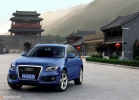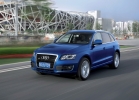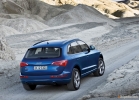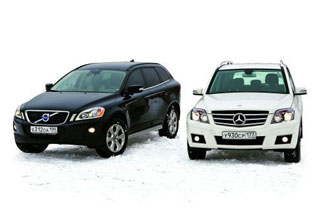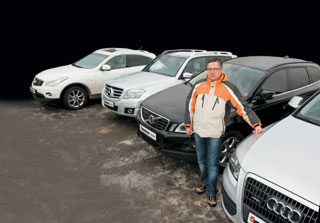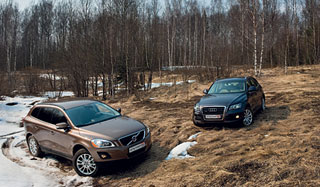Test Drive Audi Q5 since 2008 SUV
New clothes with pepper
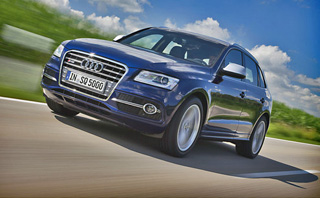 At first glance, the updated Audi Q5 has changed slightly, and under the trends, the main changes are hidden inside: the settings are folded, improved and facilitated the design. I tried the novelty on the roads of Munich, and for snack the Germans rolled up a charged 313-strong diesel SQ5.
At first glance, the updated Audi Q5 has changed slightly, and under the trends, the main changes are hidden inside: the settings are folded, improved and facilitated the design. I tried the novelty on the roads of Munich, and for snack the Germans rolled up a charged 313-strong diesel SQ5. The front part of the ku-fifth is now crowned by the traditional hexagonal grille for Audi. Head Lighting Engineering received a framing on the perimeter by strips of LED running lights, the wheels, bumper and fog, have changed, new body shades have been added to the choice of buyers and the interior design options are perhaps everything that is noticeable to the eye. For a couple of centimeters, the wheelbase of 2812 mm and width of 1898 mm increased.
It may seem that only designers worked on restyling, but it is not. Engineers from Ingolstadt applied new Rubberometallic hinges in the suspension, changed the characteristics of the springs and shock absorbers, made it easier to the transverse stability stabilizers. A compact electromechanical amplifier with a motor installed on a single axis with a rail is now working in the steering. The moment from the electric motor is transmitted through a pair of screw-ball nut for such mechanisms, and due to the coaxial installation, it was possible to abandon the belt transmission site that usually connects the motor and rack.
The use of an electromechanical steering amplifier made it possible to actively correct control wheels with random care from the traffic strip. If you do not turn on the turn signal, then when crossing the markup, the ram with a moderate vibration resists a slightly resistive.
Not only the hood, but also the trunk door is now made of aluminum, like many pendant parts and even deformation zones in front of the body.
It is after the update to Q5 in version 2.0 TFSI, a new 2-liter gasoline turbo engine was installed for the first time as part of the concern. It gives an impressive 350 Nm of torque already with 1500 rpm. and retains them up to 4500 rpm. Compared to the past 2.0 TFSI, the power increased to 225 liters. With. (+14). According to the example of Toyota in Audi, they decided to combine the immediate injection with the distributed, and now nozzles are two times larger: four operate under pressure in 200 atmospheres and injected fuel directly into the cylinder, and four more in the inlet tract and operate on partial loads.
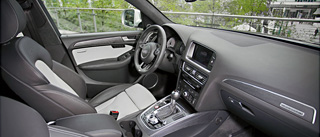 In addition, this motor has a fully electronically controlled thermostat, in which there is no traditional element expanding with increasing temperature. Instead of the usual vacuum, the electric drive is used and to control the valve pressure limit pressure. Feels like this engine is similar to diesel.
In addition, this motor has a fully electronically controlled thermostat, in which there is no traditional element expanding with increasing temperature. Instead of the usual vacuum, the electric drive is used and to control the valve pressure limit pressure. Feels like this engine is similar to diesel. Interestingly, Audi engineers gradually refuse robotic boxes with two clutches S Tronic in favor of the traditional 8-speed ZF machines with a torque converter. From now on, the robot is installed on the diesel 2.0 TDI and 3.0 TDI, and the hydromechanics on the gasoline 2.0 TFSI, 3.0 TFSI (motor with the drive supercharger, which came to replace the 3.2-liter atmospheric), and on the heavyly fuel SQ5. The octate works more smoothly and de facto will last longer, but representatives of the company claim that with the reliability of s tronic there are no problems, nevertheless the fact of the preference of ZF is evident. Probably the fact is that Audi is already preparing a new generation of transmissions with two clutches.
From the usual Q5 to try in the case, both gasoline versions with 2- and 3-liter motors were managed. Already the first modification is distinguished by confident acceleration, and the second one in the assets of 272 horses will exchange the first hundred and at all in 5.9 seconds. Direct at high speed cars are perfectly kept, if not to say it is monumental: sometimes not every big sedan can boast such reliable behavior does not need any steering correction even on a not too good road.
There are no complaints to the brakes of civil versions, but the pedal is very soft and long-term for the car with such potential, you want more intelligible mechanisms. But the sound of the engine and acceleration are great, and the esca is easily gaining 230 km / h on the autobahn, 650 nm are already available from 1450 rpm. All this is flawed by 30 mm and a more rigid suspension and, of course, more expressive appearance: huge wheels, mirrors in matte aluminum, imitation of the diffuser in the rear bumper and four-baking exhaust pipes.
Unfortunately, the Audi has already decided to abandon the supply of diesel SQ5 to Russia, and sorry is very charismatic and colorful car. But do not hurry to get upset, the Es-ku-fifth to us will still come, but already with a gasoline engine. We are waiting for.
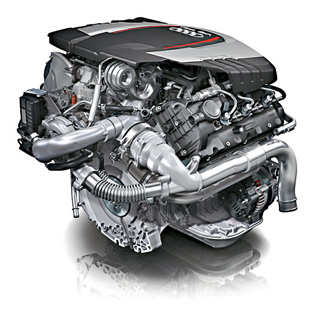
Burbodiesel V6 has two consecutive turbocharging, one of which with a variable geometry. The injection pressure is 2000 atmospheres, lubricant and cooling systems are optimized, increased ink valves, enhanced pistons and connecting rods, and the special sound of the engine is created carefully tuned release.
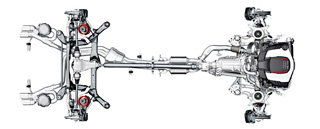
Four-wheel drive All Audi Q5 models for the Russian market have a permanent four-wheel drive with an unshaking inter-axis self-locking differential, in normal mode distributing the moment in the 60:40 ratio in favor of the rear axis
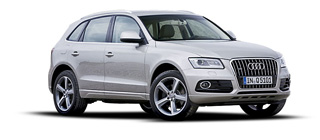
The external differences from the Audi Q5 of the old version can be counted on the fingers: new front headlights and rear dimensions (everything is decorated with LED strips along the contour, as on the younger sister Q3), the raised bumper, new wheels and the grille grille. In the cabin, more convenient control of the car system through the MMI interface, slightly modified location of the keys and new colors.
A source: Cars
Video Test Drives Audi Q5 since 2008
Video crash tests Audi Q5 since 2008
Test drives Audi Q5 since 2008
Crash Test Audi Q5 since 2008
Crash Test: Details92%
Driver and passengers
32%
Pedestrians
84%
Children-passengers
71%
Active security system



